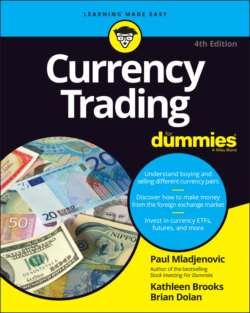Читать книгу Currency Trading For Dummies - Kathleen Brooks - Страница 34
Trading in the North American session
ОглавлениеBecause of the overlap between North American and European trading sessions, the trading volumes are much more significant. Some of the biggest and most meaningful directional price movements take place during this crossover period. On its own, however, the North American trading session accounts for roughly 28 percent of global trading volume.
The North American morning is when key U.S. economic data is released and the forex market makes many of its most significant decisions on the value of the U.S. dollar. Most U.S. data reports are released at 8:30 a.m. ET, with others coming out later (between 9 and 10 a.m. ET). Canadian data reports are also released in the morning, usually between 7 and 9 a.m. ET. There are also a few U.S. economic reports that variously come out at noon or 2 p.m. ET, livening up the New York afternoon market. (See Chapter 9 for more details on individual economic data reports.)
London and the European financial centers begin to wind down their daily trading operations around noon ET each day. The London or European close, as it’s known, can frequently generate volatile flurries of activity. A directional move that occurred earlier in European trading or the New York session may be reversed if enough traders decide to take profit (selling out or exiting long positions) or cover shorts (buying back short positions). Or the directional move may extend farther, as more traders jump onboard before the end of the trading day. There’s no set recipe for how the European close plays out, but significant flurries of activity frequently occur around this time.
On most days, market liquidity and interest fall off significantly in the New York afternoon, which can make for challenging trading conditions. On quiet days, the generally lower market interest typically leads to stagnating price action. On more active days, where prices may have moved more significantly, the lower liquidity can spark additional outsized price movements, as fewer traders scramble to get similarly fewer prices and liquidity. Just as with the London close, there’s never a set way in which a New York afternoon market move will play out, so traders just need to be aware that lower liquidity conditions tend to prevail, and adapt accordingly.
Lower liquidity and the potential for increased volatility is most evident in the least-liquid major-currency pairs, especially USD/CHF and GBP/USD.
North American trading interest and volume generally continue to wind down as the trading day moves toward the 5 p.m. New York close, which also sees the change in value dates take place. (See Chapter 4 for more on rollovers and value dates.) But during the late New York afternoon, Wellington and Sydney have reopened and a new trading day has begun.
As you can see, in terms of volume, London is the center of the forex world, but plenty of opportunities exist during the New York and Asia-Pacific sessions. As a general rule, if you trade during the Asian session and no major data releases or events have taken place, the themes from the U.S. session the day before tend to prevail. When the European session comes around, there are usually a few meaty events to move the markets and create new themes — likewise during the U.S. trading session.
